NB: most of this post is a critical discussion of Advanced Stop Lines (ASLs) – to skip to my assessment of cycle conflicts at Cobden, click here.
Another consultation, another set of Advanced Stop Lines and feeder lanes, this time a TLRN (Transport for London Route Network) scheme in Camden. And this time at least, it’s explicit why nothing better has been provided:
Camden Council and Transport for London are committed to providing high quality cycling facilities in Camden Town. As part of the design work a west to east cycle route from Mornington Crescent/Hampstead Road to Crowndale Road was explored. It was found this would require additional traffic signals and for all traffic to be stopped for a short period to allow cyclists to progress safely through the junction. The traffic impact of these changes was assessed and led to unacceptable delays to buses and general traffic.
So, high quality cycling facilities (precise detail not specified) were considered, but rejected because of additional traffic signals which would stop all traffic (presumably not all traffic though, because cycles are traffic, aren’t they…?) and hence unacceptably delay buses and general traffic. Hmm.
Or, taking a glass-half-full approach you could say we’ve got part of the way. Better options are now being considered and at least we’re hearing why they’re rejected. Like City, whose Aldgate scheme I criticised previously, I’d say Camden are currently one of the more clued-up boroughs for cycling, and there’s a lot of people in TfL who care about cycling, too. Partly, I’m criticising these organisations and schemes because here should be where we’d be seeing the really good stuff, rather than more of the same with or without apologies.
Because even if the better options are becoming thinkable, it seems they’re still not getting through the Network Assurance mincer. As at Aldgate, motor traffic has fallen in Camden Town – on the count site on the A40 near Mornington Crescent, motor traffic has halved in ten years while cycling has doubled over the same period. Yet even given this relatively favourable context – Inner London, mode shift, political support for cycling in the organisations concerned – cycling keeps on losing out. And we keep getting more of the same; except in still very unusual cases like Royal College Street (which was politically easier because, unlike most of London’s streets, there was already half decent cycle provision).
While thanks to some innovative schemes some parts of Camden are pretty good for cycling (in London terms, at least) Camden Town is an impenetrable thicket of busy roads and one-way systems. (Map courtesy Camden Cyclists: who are also discussing this junction on Cyclescape). Note the rectangle between Regents’ Canal and Tavistock Place where there’s no clear East-West route. I’d put Camden Town pretty high up on a list of ‘things to fix for cycling’, so it’s disappointing to see this scheme – which will, I agree, improve public space – giving up on cycling.
Below I analyse the problems with the Cobden scheme. If you live, work or cycle through there I urge you to respond to the consultation and join in the Camden Cyclists’ discussion. It’s good the consultation document promises moves towards an alternative high quality East-West cycle route through Camden Town, but why, as on Lower Regent Street do cyclists always have to wait for another scheme further down the line? Why can’t energy be put into prioritising those other schemes that, we’re promised, will be really good for cycling? Then advocates could decide whether that’s enough, before accepting inferior provision on other links. (Questions of network density would be important as well as infrastructure quality).
What’s wrong with ASLs?
I don’t think ASLs will fix the problems with cycling in this city. But they obviously fix some problems, or they wouldn’t have sprouted – and continue to sprout – across the country. So responses to this profusion of inferior solutions need to take this into account. I think there’s good reasons for providing ASLs, and not so good reasons. Unfortunately, the good reasons aren’t quite as good as they seem, while the not so good reasons help explain why we keep getting ASLs despite that.
The rise of ASLs
The first UK ASLs appeared in Oxford, Newark and Bristol in the mid 1980s. These were seen as ‘demonstration schemes’ and funded by the Department of Transport. (for more on this, see Wheeler, A.H., 1992). The Dutch installed a number of ASLs in the late 70s and early 80s and, in one of our periodic flurries of ‘innovatory project’ enthusiasm, the ASL reached these shores.
And stayed here, while the Dutch have increasingly moved away from them. You’ll find one on page 187 of the CROW Dutch Bicycle Design manual as one intersection treatment among many; whereas in the UK they have become the default ‘cycle provision’ option. (National cyclists’ organisation CTC states ‘There should be a presumption in favour of providing Advanced Stop Lines (ASLs) on all arms of all signalised junctions.’) ASLs feature on the front of many cycle infrastructure and policy documents, and are found across the country, from high to low-cycling cities.
What was the purpose of these first ASLs? According to Wheeler, the initial perceived benefits of the ASL were related to safety and conflict reduction, with the following benefits cited:
- allowing cyclists to clear the junction first, reducing the risk of conflict with motor vehicles
- making cyclists more visible to motorists
- allowing cyclists to turn right without having to cross a stream of traffic
- helping to prevent left hooks
Elsewhere a health/ambiance benefit is cited, as cyclists using the ASL are no longer directly behind motor vehicle exhausts while stopped at the lights.
ASLs and safety: not quite what it seems?
Like any piece of infrastructure, transport cultures impact the use of ASLs, and motorist behaviour has long been a problem. Wheeler reported that ‘Encroachment on the reservoir varied from 13% to 24% of motorists arriving during the red, and was more frequent than was hoped’. (And incidentally, higher than the proportion of cyclists jumping the lights). Later research in London (a 2006 Atkins study for TfL, on Advanced Stop Line Variations) found an even gloomier picture: of the 10 sites studied, between 9% and 54% of motor vehicles encroached by at least 25%. And over all 10 sites, more than half of all powered two-wheelers encroached by at least 50%.
However, the key problem with ASLs isn’t encroachment. It’s that, even if they protect cyclists, they only do so on a part time basis, and the rest of the time they might even make things worse.
Generally, there’s relatively little evidence on the safety impact of ASLs. The UK before and after studies I found tended to be too small scale for evidence to be reliable; a study in Portland, Oregon found some reduction in conflicts but did not analyse actual collision data. The authors comment that ‘in practice drawing valid conclusions from available crash data has proven very difficult.’ I think it could be possible (although in practice difficult) to analyse collision data from London ASL and control sites, as I imagine you’d have enough data now, but as far as I can tell this hasn’t been done.
That said, intuitively, it seems reasonable to suggest that there may be a safety benefit for cyclists arriving when the lights are red. A TRL study ‘Behaviour at Advanced Stop Lines‘ (for TfL) argued in favour of a safety benefit through reduced left hooking, as ASLs increased the proportion of cyclists able to get in front of motor traffic when lights were red. Similarly, right turning cyclists can potentially avoid having to move out across lanes of motor traffic.
Yet, these stated safety benefits only work when cyclists get a red signal. For cyclists arriving when the lights are green, on the other hand, it’s arguable that ASLs may even increase problems. Many advocates have pointed out that ASL feeder lanes or gates (usually located next to the kerb) tend to put cyclists into the worst possible position in relation to left hooks (particularly but not only in relation to possible HGV blind spots), as well as making it harder for them to turn right. Left hand feeder lanes and gates put cyclists in completely the wrong position a substantial proportion of the time.
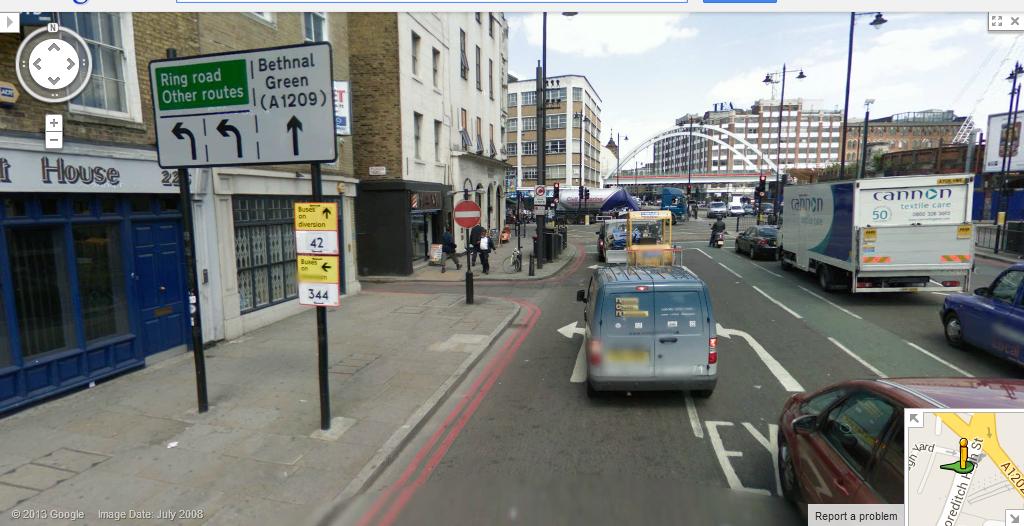
A central feeder lane. I don’t much like using this lane on my own. I certainly don’t want to ride along it with my Mum or my niece.
And it’s hard to imagine children and older people wanting to move into central feeder lanes to position themselves between lanes of motor traffic. I don’t like doing it myself and I’m a ‘hardened commuter’ who’s had Level 3 cycle training.
So how often do cyclists get the benefit of ASLs? The Atkins study found that only 44% of cyclists arrived at the ten sites on a red light, with the percentage varying between 23% and 83% at different junctions. The lazy solution to this problem, as implemented at Bow, is to make cyclists always wait, while motor vehicles will wait only perhaps half of the time. The likely outcome of making cyclists always wait for motor vehicles is frequent non-compliance: after all, one reason for implementing ASLs was that they formalised the existing behaviour of cyclists, which involved filtering rather than always waiting for motor traffic. (The fact that injury stemming from this predictable non-compliance will then be the ‘fault’ of the cyclist concerned is really not an excuse).
Other cited benefits of ASLs
I would add four other benefits, articulated in other work on ASLs; in my opinion, the least good – and yet most important – reasons are numbers 3 and 4.
- They can provide a speed benefit for cyclists
- They mimic the behaviour of people already riding in motor traffic
- They don’t involve high levels of cost or political commitment, or much in the way of infrastructure; often it’s just a question of paint
- They can often be implemented without taking lanes away from motor traffic; in which case they have a neutral or even positive effect on motor traffic capacity and flow
Formalising what people do anyway
ASLs are claimed to formalise what cyclists do anyway. This is probably an important reason why cyclists often say in ‘before and after’ surveys that they’d rather have ASLs than not.
This argument is used in introducing changes for pedestrians; TfL’s guide to Measuring Pedestrian Activity explains how this works. In planning for pedestrians in London, it’s common to carry out counts, assess what pedestrians are already doing and how that relates to current provision: for example, whether people are crossing informally because crossing points are not on desire lines.
This analysis can be found for Aldgate here. It’s interesting to note how the analysis doesn’t just look at ‘what pedestrians do now’ but places it within a framework critical of existing street design: the report argues that the subways are off-putting, or railings get in the way, as a means of explaining the lack of activity in certain places. So you can’t just measure existing activity patterns, you also have to link it to where you don’t see people crossing – and why.
‘Measuring Pedestrian Activity’ suggests it’s also important to consider specific groups excluded by walking environments. As Asher et al (2012) found, most older pedestrians are unable to cross the road safely because crossing times are too short. ‘Measuring Pedestrian Activity’ recommends planners ‘record the persons with an obvious mobility impairment (e.g. in a wheelchair or using a walking aid) or pushing a pram.’
So the ‘what people do anyway’ argument must be set within a broader context asking what the environment is like, who is likely to use it, and who is excluded. And when it comes to cycling, we’ve built a cycling environment in the UK that has excluded the vast majority of potential cyclists. People with mobility impairments, children and those travelling with them, are just two of the groups disproportionately affected by this, but there are others: women, older people, and people from many Black and Minority Ethnic groups, are less able and/or willing to cycle in London. For many people, cycling just doesn’t enter their ‘choice set’: they don’t consider cycling as a possibility.
So, if we use the ‘what people do anyway’ argument without care, we may generalise from patterns of behaviour that aren’t representative of mass, inclusive cycling, or from patterns of behaviour that are only feasible when cycling levels are low. Another innovation based on ‘what cyclists do anyway’ has been to create shared pavements; as it’s clear that a proportion of existing cyclists use pavements to avoid behaving like ‘traffic’. Solution: let them legally use part of the pavement.
But creating shared pavements, like creating ASLs, is creating a normative ‘ought’ from a deeply problematic ‘is’. How cyclists currently behave does tell us something: but not about design solutions, I think. It tells us about problems; how people have to choose between being like a motor vehicle and being like a pedestrian (of course, most people in the UK still vote with their feet and choose ‘neither’). In response to this behaviour, we should allow people to be ‘people on bikes’; yet instead, we still often create and reinforce environments where people can either potter about on pavements like pedestrians, or where they must speed to the front of a queue of motor vehicles while they can, then waiting, hands and legs poised, to rush off ahead of the cars.
And then, having created an environment that encourages speedy, competitive cycling, we wonder why some cyclists behave like inconsiderate speed demons…
Reasons 3 and 4: ASLs have low political costs
However, there is another extremely important reason why Advanced Stop Lines have proved so popular. They have low political costs. Mainly a matter of slightly tweaking the existing set-up with some paint, they have the highly attractive side effect of not decreasing, and potentially even increasing motor traffic capacity. A TRL study on this topic (Wall et al 2003) found that in practice, sites given an ASL plus nearside feeder lane tended to see a slight increase in motor traffic throughput, as long as no motor vehicle lanes were removed. For those seeking to ‘balance all modes’, this is a free gift – extra space for cyclists without taking away space for motor vehicles.
The result is perhaps not surprising. If cyclists are more easily able to reach the ASL during red phases, they can quickly move out of the way of motor traffic, whereas if – as without and ASL – they’re distributed more randomly in the traffic queue, as they are less able to reach the front, the resulting delays to cars may in fact be slightly greater.
As the TRL report on ASLs and capacity states, ‘ASLs were shown to have no significant impact on junction capacity unless a traffic lane was removed in order to install them.’ No wonder we are seeing ASLs continually appear in junction plans, despite their limited and part-time protection, and their unattractiveness to many people who don’t currently cycle. They don’t cause problems for ‘maintaining traffic flow’, and this is the key.
While I have argued that ASLs are at best a half-hearted solution for cycling, they do tick all the boxes, in terms of political costs (which ultimately are what matter, rather than financial costs, at least in London).
On the plus side: no need to re-think how things are traditionally done, merely add a line of white paint and a box at the junction.
Also on the plus side: no opposition from more established and powerful transport interests, which oppose reduction in motor vehicle capacity.
On the minus: there may be some complaints from cycling advocates.
So far, the first two considerations still keep outweighing the third. But those planning bodies who want more cycling need to be bolder. Car ownership and use has peaked in London, and we need to manage decline, not to prop up a system that’s on the cusp of transformation. Some very interesting information on this theme can be found in TfL’s RTF Technical Note 10 entitled ‘What is the capacity of the road network for private motorised traffic and how has this changed over time?‘. This Note demonstrates how giving over large amounts of space to buses reduced capacity for private motorised traffic, contributing to a virtuous circle of mode shift.
It explains that capacity for private motorised trips has ‘reduced most in central London – down by about 30 per cent. […] In inner London the loss was about 15 per cent, with an approximate 5 per cent loss in outer London.’ It continues: ‘This reduced capacity has impacted on levels of service on the road network […] All other things being equal this reduced level of service will cause marginal road users to make alternative travel arrangements, moving their trips onto alternative modes, feeding back in the form of reduced ‘expressed demand’ on the network.’ In other words, it confirms that re-allocating motor vehicle space, and using it to create more capacity and better conditions for other modes (so far, primarily buses and walking) created the conditions for London’s modal shift.Although there’s only been a relatively small shift to cycling, we’re seeing as a legacy growing demand for cycling. This demands a bold response from planners: as was done before with bus priority and streetscape schemes, a willingness to re-allocate capacity, to do things differently, and see what happens. It won’t mean cutting motor vehicle capacity everywhere, but, certainly refusing to reduce motor vehicle capacity anywhere is stymieing London’s nascent cycling revolution. Re-allocating capacity, given cycles – like buses – are efficient people carriers, should also mean increasing people-carrying capacity. And ultimately, to keep London moving, we need our streets to move people, not metal boxes, as efficiently as possible.
What might be better than ASLs: Green Scrambles?
I’m not an engineer, and there are lots of people better qualified than me to work out the details. But one idea I’d like TfL and the boroughs to try out at junctions, as an alternative to ASLs, is a simultaneous green for cycles, or a ‘green scramble’. I have it on good authority that this is currently possible. DfT permission is technically needed for what would be seen as on-street trials (although sometimes authorities just go ahead with ‘innovations’), but there’s no legal changes that need to be made, unlike allowing cyclists to turn left on red or allowing cyclists to turn across a pedestrian green phase.
A green scramble has numerous benefits. It allows cycles to turn right in one go, negating the need for the two-stage Danish turn. It removes conflicts between bikes and motor vehicles, replacing this with conflicts between bikes. This has two benefits: firstly, the impacts of any conflicts are likely to be much less severe, and secondly, positive impacts on cyclist behaviour. Rather than being encouraged to speed in front of motor vehicles, and set off as quickly as possible, cyclists instead need to negotiate their path with other cyclists, make eye contact and yield as necessary.
Within the context of busy main roads, a green scramble for bikes accompanied by high quality separated space could be one way of getting to that really good at junctions that we’ve been waiting for. It could be good enough for children, old people, and other groups who currently are very unlikely to cycle in London. This could help create a virtuous circle like the one we’ve already seen; to quote ‘As Easy As Riding A Bike’, ‘these arrangements do involve adding a phase to the light signals, and so will reduce the junction capacity for motor vehicles. Of course, there are many less motor vehicles queuing [at a simultaneous green in the Netherlands] than might be the case, due to the large numbers of journeys being made on bikes. (…) Bicycles are more efficient than cars, so facilitating their use benefits everyone.’
For more on green scrambles in the Netherlands, see here and here.
Cobden Junction: Cycle Conflict Analysis
I hope the discussion above has made it clearer why ASLs are not good enough and don’t count as removing conflict. Unlike green scrambles, and some other means of reducing conflict at junctions between cycles and motor vehicles, they remove at best only a part of the conflicts; at worst, this is at the cost of aggravating conflicts at other times (when cyclists meet a green light). Therefore they cannot be seen as solutions to the two major problems cyclists encounter at junctions, being left hooked, or having to move right across lanes of moving motor traffic.
Here I provide a Cycle Conflict Analysis focused on the Cobden scheme, based on information available on the consultation document and via DfT’s traffic counts. You can access the consultation document here.
About the Cycle Conflict Analysis (CCA)
The CCA uses five criteria from the LCC’s Love London, Go Dutch matrix which assess specific conflict points at junctions, speed and volume criteria, and protection from HGVs. Missed opportunities to allow cycle contraflow through junctions are also highlighted (coloured in black).
5. Calm Junctions
(a) Can cyclists make right turning movements separate from motor vehicles?
(b) Have left hook risks been eliminated?
Failure to meet ‘calm junction’ criteria is highlighted red.
3. Adaptability
(a) EITHER a credible, evidenced plan to reduce motor traffic volume to levels compatible with mass cycling OR protected space
(b) EITHER motor traffic speeds of 20mph or less OR protected space
(c) Have satisfactory measures been taken to separate cyclists from HGVs?
Failure to meet ‘adaptability’ criteria at other turning movements is highlighted orange.
Clockwise from the top, the count sites highlighted are 37100, 36368, 17008, and 56751. As of 2011, the daily flows of (a) all motor vehicles, (b) all buses, and (c) all HGVs were as follows –
37100: (a) 25,225 (b) 1,529 (c) 1,064
36368: (a) 8,034 (b) 831 (c) 296
17008: (a) 15,438 (b) 1,033 (c) 542
56751: (a) 13,226 (b) 878 (c) 539
Most of the roads in the section I’m discussing are TLRN (TfL-controlled) roads, meaning that they fall outside the Camden borough-wide 20mph limit scheme and so will remain at 30mph.
Speed and volume criteria used in When do Cyclists Need Protected Space suggest that (in the absence of clear plans to substantially reduce motor traffic volumes and speeds) all sections need protected space for cycling (for example, through banning conflicting turns, or through providing a ‘green scramble’); hence none of the turning motions can be categorised as green unless this is provided. The next step is to establish which of the turning motions are critical and which are banned.
Cycle Conflict Analysis: assessment of potential conflict points at Cobden junction
Summary
Four conflicted turns – left hook risks or unprotected right turns
Three other turning movements where cyclists must mix with high volume or high speed motor traffic
Four banned turns
Detail
Coming from Crowndale Road
Left turn unprotected, with high levels of motor traffic and HGVs
Straight on with left hook risk
Right turn across heavy motor traffic and HGVs
Coming from Eversholt Road
Left turn unprotected, with high levels of motor traffic and HGVs
Straight on with left hook risk
Right turn banned
Coming from Camden High Street
No cycle contraflow, therefore potential Southbound straight on and left turns are banned
Southbound on Hampstead Road
Right turn across heavy motor traffic and HGVs
Northbound on Hampstead Road
Left turn unprotected, with high levels of motor traffic and HGVs
Right turn banned
Conclusion
As it stands this design is highly problematic for cycling, in terms of junction conflicts, with none of the junction movements rating a ‘green’ (indicating safe and inviting cycling conditions suitable for a wide range of potential and current cyclists).
Some junctions are rated critical because of conflicts between cyclists and left-turning motor traffic, or between right-turning cyclists and motor traffic. Many cycle movements are banned or are made lengthier than necessary.
If we wanted to quantify the junction, in terms of cycle conflicts, it would score 3/22 (where green rated movements score 2, amber rated movements 1, and red rated or banned movements score 0).
Alternatives
The design might be acceptable if there were high quality alternative routes nearby. However, this is not currently the case.
Please make your views heard on the Cobden junction consultation here.


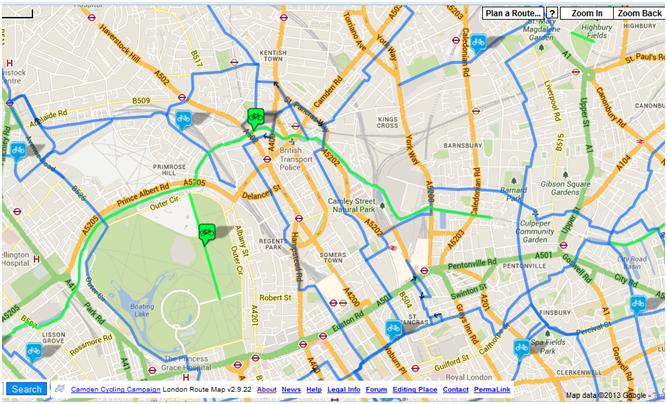
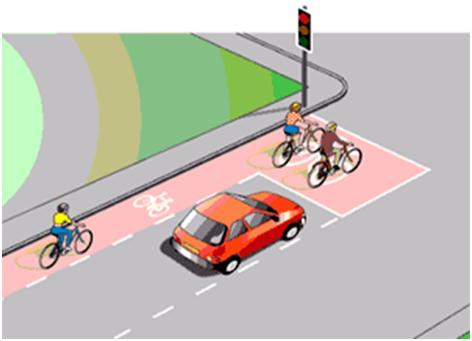


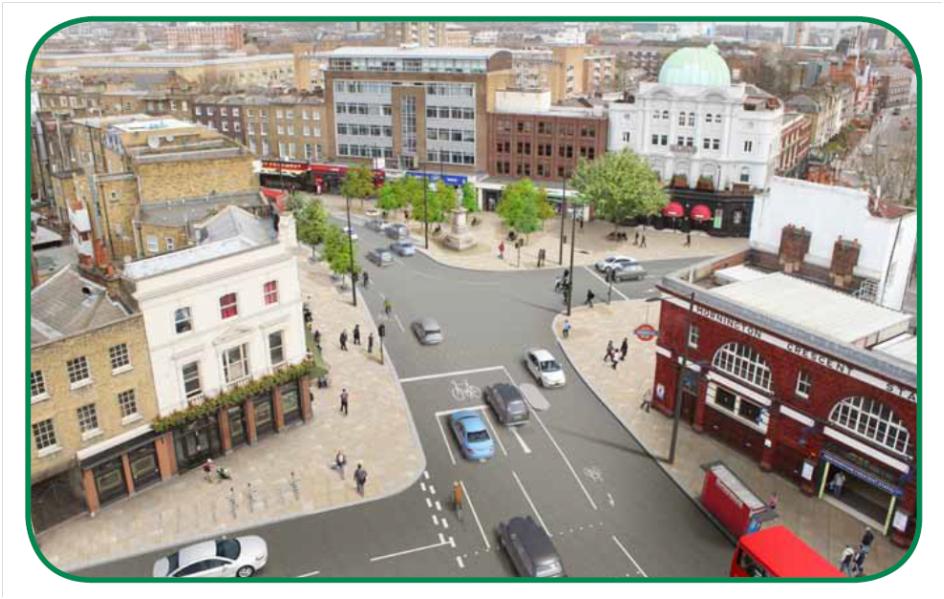
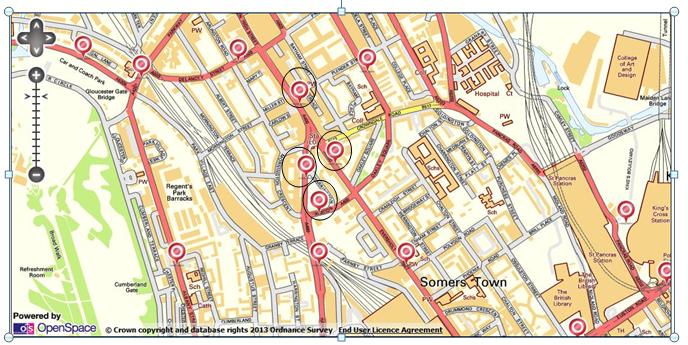
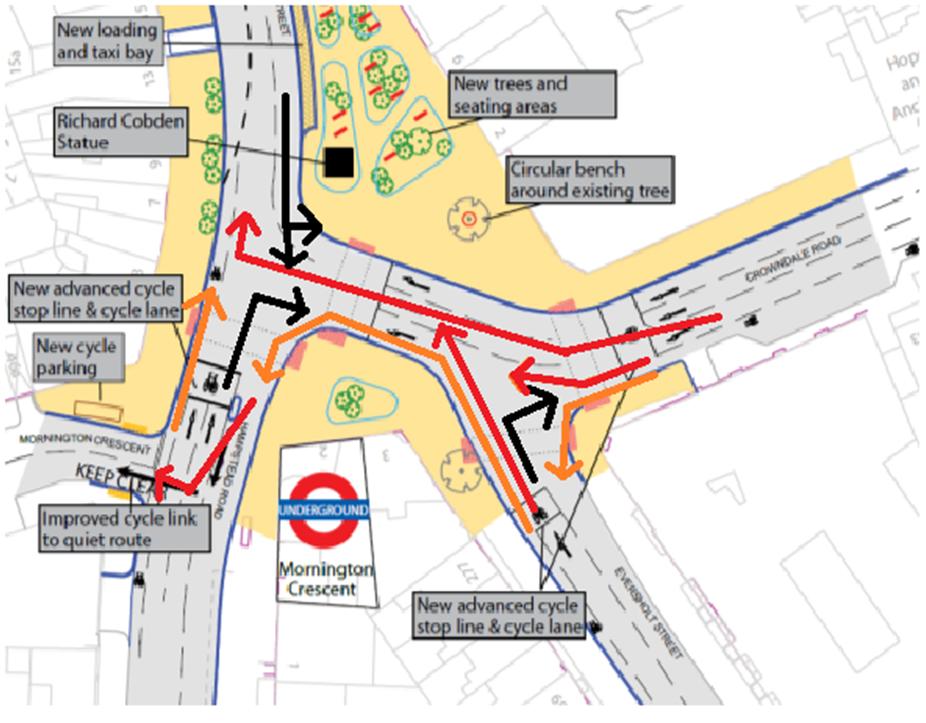
The missed opportunity for an eastbound cycle contraflow along Crowndale Road, linking up with Royal College Street further down is criminal 🙁
The same goes for a contraflow down Camden High Street, but I can see how unpopular that would be.
You make some very good points, and I would love to see the ‘green scramble’ and other approaches tested. [As you will see below I would also like to see ASLs tested!!]
However I feel your analysis of ASLs is too negative, for at least the following 2 reasons…
a. The top test of ASLs (or any other traffic facility) must surely be data on outcomes rather than a theoretical analysis of what is good and bad about them, however useful that may be. Whilst you are I am sure right that more research is needed, the research that has been done does suggest pretty firmly that ASLs overall reduce conflicts and are welcomed by most cyclists and most motorists. The Oregon conclusions seem more positive than you imply, and you don’t mention the OECD report which is referenced in the Wikipedia article on ASLs. You say that data is potentially available from London, with control sites etc – it is crazy that we have so many ASLs and so little research, and surely this research should be pushed strongly – can you or LCC or others push for this?
b. In stating the claimed benefits of ASLs you don’t refer to the benefits (or indeed the disbenefits) to road users other than cyclists. However the OECD report refers to potential benefits to pedestrians. Also, I was told that data from early ASLs in Edinburgh (presumably a very small sample, and I don’t have any figures) suggested reductions in crashes for all types of road user (peds, cyclist, motor). That seems likely, since ASLs generally provide improved visibility of and by all users of the junction. Again, the benefits/disbenefits to all road users can only be tested by research and it seems crazy that it has not been done.
Politically, it is unclear whether the current critics of ASLs are calling for existing ASLs to be removed, or for no more to be installed, or just for the trial of alternatives, or what. However the impression often given is that ASLs are worse than useless – the implication being that they should all be removed. It would be really helpful for critics to clarify this.
The limited research so far suggests ASLs are significantly better than no junction treatment. If that is the case then they should in general remain except at locations where other alternatives are being tested. And as stated above, I would love to see other alternatives tested.
As regards the specific junction you mention, I don’t know it at all, but obviously it’s a pretty complex case, and since work is to be done there it looks like a great opportunity to try out something much more cycle-friendly than what is currently proposed.
Thanks Dave for your very detailed and thoughtful response. I agree with a lot of your points (and I’d accept that I stressed the negatives, partly because of frustration that ASLs and feeder lanes just seem to get put in without question, and in my view often for bad reasons).
On the OECD references, both the Swedish and Danish studies are quite old and not easily available online (at least in English!) Without reading the whole thing, it’s hard for me to take account of them as I can’t tell what they’ve evaluated and how. When I get some time I’ll see if I can do some detective work, but it’s possible that the context is so different it’s not that easily applicable.
You’re right that people should ask for more evaluation. I intend to do so inasmuch as I can. There are a lot of potential confounding factors though, so I’m not 100% sure the evidence will give us a definitive answer.
On what to ask for: I wouldn’t ask for ASLs to be removed and replaced with nothing (unless they are particularly problematic, perhaps). There’s other priorities. But I really don’t think ASLs should be our default junction option anymore. I think that, as in the Dutch manual, they should be one option among many, to be used in particular circumstances, and we should always consider other options, as well as start thinking about replacing ASLs with better solutions where they’re not appropriate.
So TfL and Camden Council “are committed to providing high quality cycling facilities” – but they’re not actually going to provide any because they’re even more committed to providing high-capacity junctions for motor vehicles.
So what are they really committed to? (Apart from bald-faced lies about being committed to cycling, of course.)
Thanks for a very thoughtful and well researched article. I am especially grateful for you taking the time to analyse thoroughly the proposal and the role of ASZs.
As a regular cyclist in London it’s always disappointing to see that when a junction is being upgraded all policy statements about putting “vulnerable road users” on top of the user’s hierarchy disappear as mist before the sun because priority is given to the almighty motor car. In my humble opinion there is a potential for further reducing the need for private motor vehicles in Central London ( Zone 1-2), but this is not taken into account when planning new upgrades of junctions / roads.
Thanks to your article I have submitted my opinion to Camden Council. I’m afraid I’ve become a bit cynical about cycling infrastructure in London, and I now consequently oppose any project that propose half hearted measures. At least the local politicians should not be able to say “look campaigners, we’ve created X numbers of ASLs and painted them in a nice colour, so you’ve got what you wanted” when the ASLs count for next to nothing in terms of cycling safety.
There was also an early ASL at Cambridge. This sign, which was I believe 20-30 years old until it finally disappeared a year ago, explained to motorists how to use the ASL (shown further ahead in the picture) :
http://www.cyclestreets.net/location/5261/
Another junction with cycling facilities box checked with a few ASLs (which as you point out, have a dubious impact). Thanks for drawing attention to these plans and I’ll definitley add my voice to the consultation.
Also, as a point of order, Camden High St is a 20mph zone, despite also being a red route (see the FAQs on the 20mph consultation). It doesn’t make any difference to the analysis of the junction but proves that 30mph is not needed in all cases by TLRN
Most of the problems you see with ASLs are to do with feeder lanes rather than ASLs themselves. I have always seen ASLs as primarily a safe, legal place to wait for the lights to change, for cyclists who have chosen to filter past a traffic queue. There is no compulsion to use them, or to filter. The safety benefit is from being in a traffic lane, visible, rather than invisible beside one, when the lights change. When the light is green and there’s no queue, both ASL and feeder lane are irrelevant. The presence of any kind of cycle lane makes some drivers expect cyclists to stay in it, which is why I tend to favour gates over feeder lanes. The present legal requirement to enter ASLs by the feeder lane should be ignored by cyclists and repealed by parliament.
While separate traffic light phases for cyclists delay other traffic, they also delay cyclists, by increasing the probablilty of arriving with the light red, and the time to the next green. Denmark has the advantage that a green traffic light is never absolute, and turning drivers know to give way to straight-on pedestrians and cyclists. Without this becoming accepted here, it’s hard to see how segregated cycle infrastructure can avoid increasing cyclist journey times, except by squeezing out almost all other traffic.
The elephant in the room continues to be driver behaviour. Without changing this, cycling will continue to be frightening, regardless of how much or how little segregated cycle infrastructure you provide.
Rachel,
I have posted some comments about your assessment of Cobden Junction on the Cyclescape thread about the consultation at http://www.cyclescape.org/threads/936.
I entirely agree with your assessment of ASLs.
George
Very good discussion on ASLs. There was a time, about 10 years ago, when London traffic engineers were expected to put ASLs in at every upgraded signal junction. That was changed by the Road Traffic Management Act being interpreted to give priority to motor traffic capacity over safety considerations.
They are a low order solution best suited to where there is a high number of right turning cyclists (as used in Netherlands). On new designs for major junctions such as Cobden only providing ASLs is evidence of design failure.
The ASLs that work best are where a general traffic stacking lane has been taken out to provide the feeder lane. All too often the potential benefits have been eliminated by substandard narrow feeder lanes or no lane at all in order to maintain or increase motor traffic capacity.
Overall I think it is too soon to ditch the ASL, it is likely that the research to date is inconclusive because of the poor quality of ASL and feeder lane we see and also the general refusal of most police to enforce them.
I was disappointed to see reproduction of the confusing HGV changing places picture. The black area around the lorry cab is the area that MUST be visible in the driver’s mirrors. There are other areas further to the left that are truly blind, being out of range of the mirrors. A cyclist hit in the area shown is one that the driver should have seen unless they were driving too fast to look properly. Very few police understand this. Even the Mayor’s publicity team misrepresented this area in their launch of his London Lorry Zone consultation.
Great post. The same conflicts occur with ADG for pedestrians (a.k.a. Barnes Dance) and similar avoidance techniques are used. The Barnes Dance is trickier as you actually do make eye contact and then you start doing the whole anticipatory go-left oops go-right oops go-left mirroring movements with an oncoming human, unlike the bike ADG where you watch the front of the other bikes to judge where the humans on them are going and where the right gaps is.
And as an experienced traffic engineer I can tell you that you are doing “engineering” with your analyses. Don’t let any blocking engineers tell you otherwise. It’s definitely not rocket science what we do and we often don’t understand and/or allow for the human behaviour factors properly.
It’s funny how spoilt you get riding a bike in the Netherlands. I was at that Groningen intersection on a bike in August and found the waiting time and queue in the peak period onerous even though when I was there all waiting cyclists made it through the ADG phase in one go. As cycling continues to grow I expect that they may change the phasing to two ADG phases in the one signal cycle in the peak periods, at the expense of additional delays to motor vehicle users.
Rachel,
Excellent analysis.
One point of disagreement:
“Alternatives
The design might be acceptable if there were high quality alternative routes nearby. However, this is not currently the case.”
The junction is shortly before Camden High Street. A high street is not a motorway. People should be able to reach the high street with their bicycles in comfort and safety. Even if there were alternatives nearby, CHS and roads leading to it still need to be made safe
Pingback: Cobden Junction, Camden - Consultation - London Fixed-gear and Single-speed
To give the ASZLB (I prefer B “boxes”) bit some more not-London-but-close-by perspective. The only thing I personally have against ASBs is that they may be wasting money which could perhaps be better used, for example, on a few well placed bollards, as per the game Kevin Hickman/David Hembrow have proposed. This is because I simply ignore them. If I’m in front of motor traffic, I’ll go into them, if not I’ll be in primary in the appropriate lane behind the last vehicle that overtook. I won’t use the filter lane because one doesn’t know when the lights will change and leave one in a compromised position. However, most people aren’t too happy with such a vehicular solution and for those people ASBs seem to encourage generally unsafe behaviour, which becomes particularly problematical at non-ASB junctions. For example, at weekends we see a lot of London cyclists in Surrey, where ASBs are still relatively rare, and they generally behave as if they have an expectation that there will be an ASB at the front of motor vehicles queueing at traffic lights. So in such situations I am frequently treated to the sight of streams of cyclists making their way by all avenues to the imagined ASB only to find themselves beyond the one and only stop line. And when that is full up, some get backed up on the left in what are left filter lanes for motor vehicles, but want to go straight on, thua inviting a left hook. And roads round here are often >30 mph, so drivers will hare off rapidly from lights narrowly overtaking a bunch of wobbly cyclists trying to clip themselves in. So whether or not ASBs in London work, they may be encouraging unsafe behaviour in nearby areas where there aren’t many ASBs. (On weekdays, the Surrey streets return to a different equilibrium, with the local cyclists negotiating the ASB-less junctions in completely different ways – they certainly don’t force themselves to the front.) This is of course a result of the confusing lack of consistency of treatment that is characteristic of infrastructure in the UK, which must cause as many problems as the merits and demerits of any given individual piece of infrastructure.
I struggle with many ASL installations on one or more of the following counts:
1) Absence of feeder lane (common here in Aberdeen).
2) Feeder lanes up the left of waiting traffic.
3) Presence of ASLs in ahead only right hand lane of multilane roads. No-one is going to use this facility so what are they for? To get across from the feeder to the right turn lane? Only if you have complete confidence in the traffic light sequence. They take up road space unnecessarily in my view which in turn could fuel resentment against bicycle use.
4) Uncertainty over when lights will change.
5) Getting to the box only to discover it is occupied by a motorised vehicle (common practice amongst taxi drivers here).
Points 2 & 4 could be addressed with the use of countdown timers above traffic lights, like this example for pedestrians in Singapore:
http://www.flickr.com/photos/92367207@N03/8521005373/
Maybe have the numbers flash as they reach 4 seconds to remind riders not to press on the the front.
There are a couple of ASLs I use regularly and I wouldn’t want to see them removed altogether but they need something to reduce the uncertainty surrounding the traffic light sequence.
Rachel, you state “… the key problem with ASLs isn’t encroachment. It’s that, even if they protect cyclists, they only do so on a part time basis,”
While this is a problem with many ASLs because either drivers wish to overtake riders once through the junction after the lights change or when moving through junctions when the light is green, a solution to this (and many other conflict situations) is to minimise the speed differential between the modes so drivers feel less inclined to overtake and riders are happier to remain central in the lane. At many junctions in hackney such as along the A10 riders stay in the lane (and even better in the bus lane) and seem happy to remain central or and drivers often hang back with no aggression.
In fact encouraging riders to take up a lane (without needing to be really confident and assertive and helping drivers accept through design, enforcement and education may be a much better way of utilising space on London’s roads. As you know, Rachel, Hackney have gone much further with this than Camden creating a linked up cycle/ walking friendly environment that keeps improving
Pingback: The new Mornington Crescent junction design is an insult to us all | The Alternative Department for Transport
Pingback: Town planning and cycling a.k.a bad junctions - London Fixed-gear and Single-speed
Pingback: Space Invaders | As Easy As Riding A Bike
Pingback: Junctions designed to avoid left hooks
Pingback: Blind Spots, Advanced Stop Lines and why they are a trap - Cardiff By Bike